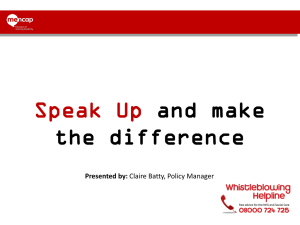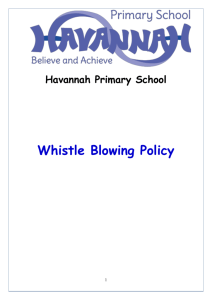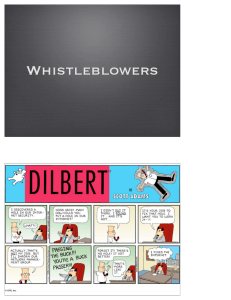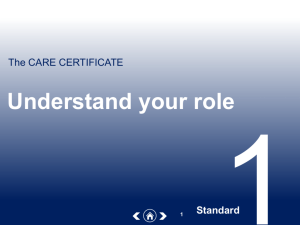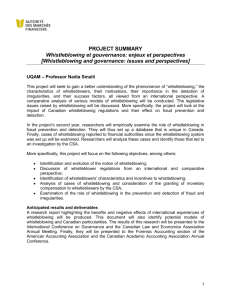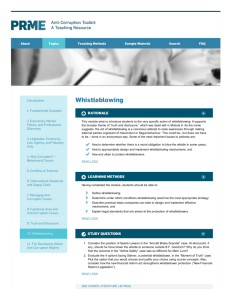The Challenges of Whistleblowing Implementation
advertisement
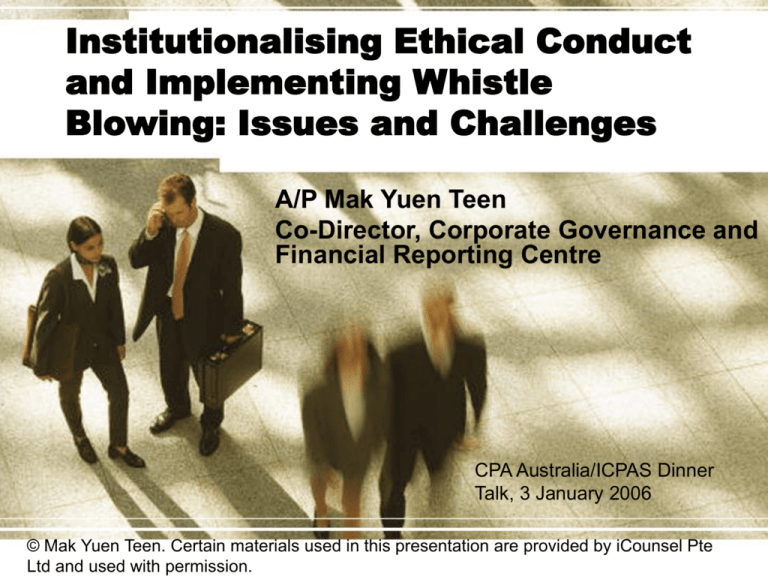
Institutionalising Ethical Conduct and Implementing Whistle Blowing: Issues and Challenges A/P Mak Yuen Teen Co-Director, Corporate Governance and Financial Reporting Centre CPA Australia/ICPAS Dinner Talk, 3 January 2006 © Mak Yuen Teen. Certain materials used in this presentation are provided by iCounsel Pte Ltd and used with permission. Why Develop a Code of Ethics/Conduct? • Regulatory requirements/best practice recommendations (U.S., Australia) • Compliance with the spirit of the law and minimise reputation risk from ethical breaches • Institutionalising an ethical culture • Building sustainable long-term shareholder value Code of Ethics/Conduct: Regulatory Initiatives • US: Sarbanes-Oxley Act requires companies to disclose whether they have adopted a code of ethics that applies to the company’s senior financial officers and, if not, to explain why NYSE rules now require that a “code of business conduct and ethics for directors, officers and employees” be disclosed. Any waivers of the code should also be disclosed. Code of Ethics/Conduct: Regulatory Initatives • Australia: The ASX recommends the establishment of a code of conduct which should be made publicly available. Key Steps in Developing and Implementing a Code of Ethics/Conduct Assess current ethical culture/program Identify desired core values Writing the code Identify key elements Consultation process Implementation process Key Steps in Developing and Implementing a Code of Ethics/Conduct 1. Assess your organisation’s present ethical culture and program to identify gaps between current practices and best practices 2. Identify relevant core values desired by your organisation and stakeholders – – e.g., SingTel’s core values are “customer focus, challenger spirit, teamwork, integrity and personal excellence” BP’s core values are “integrity, honest dealing, treating everyone with respect and dignity, striving for mutual advantage and contributing to human progress” Key Steps in Developing and Implementing a Code of Ethics/Conduct 3. Identify key elements, e.g., – – – – – – ensure interests of key stakeholders are taken into consideration ensure the program covers all levels, including directors, management, employees (how about suppliers and business partners?) identify all key legal/ethical issues arising from the company’s operations, both locally and overseas identify the program “champion”? form ethics committee ensure process for communicating, training, monitoring, enforcing and updating is in place Key Steps in Developing and Implementing a Code of Ethics/Conduct 4. Writing the code, e.g., – – – – use plain personal language and positive tones focusing on what should be done, not what should not be done use a user friendly format which is well organised and structured, and easy for employees to understand and find answers to situations faced be specific as to problems and issues facing the organisation; give examples including problems faced by organisation in the past include a duty to act honestly, fairly and with integrity to set a higher standard than just complying with letter and spirit of laws and regulations Key Steps in Developing and Implementing a Code of Ethics/Conduct 4. Writing the code, e.g., – – – – – – provide examples of ethical dilemmas and asking questions like “how would I and the organisation look if my actions appear in tomorrow’s Business Times front page?” provide tools for resolving ethical dilemmas, e.g., checklists, prescribed steps, list of questions to ask oneself before making decision provide contact persons that employees can approach before making decision if they have doubts make code part of employment contract make reporting of ethical breaches part of employee duty and provide secure avenues for reporting breaches (whistleblowing) specify enforcement actions for unethical behaviour Key Steps in Developing and Implementing a Code of Ethics/Conduct 5. Consultation process – consult with employees, stakeholders and overseas units to ensure appropriate content, language, style and format 6. Implementation process – – – introductory letter from CEO indicating board/top management endorsement circulate widely to all who are covered at least annually and get them to acknowledge receipt and commitment to adhere publicise code to stakeholders (mention in annual report; put code on website) Walking the Talk: Ethics versus Competence Gu Yanfei tipped to be new CAO head [Business Times, 19 October 2005] `She is the only one, at this point, who can effectively handle relations between CAOHC and the Singapore team - a matter which is key to CAO's future survival,’ a source told BT. `No one can manage the concerns of both sides as well as she can.’ Sources, however, also told BT that Gu may not be appointed chief executive immediately or in the near future as she still faces criminal charges relating to the CAO scandal. She was charged in June for breaching her fiduciary duties as a director and for failing to disclose CAO's huge options trading losses of US$550 million to the Singapore Exchange. The maximum penalties are a fine of up to $250,000 and/or jail of up to seven years. Sources say it's likely that an interim CEO will be appointed first, with Gu taking over only when her charges are resolved - even if that means she will only become CEO a year from now. Walking the Talk: Ethics versus Competence Poll, SAICSA Dinner Talk, 8 December 2005 (76 responses Walking the Talk: Ethics versus Competence Brilliant boss faces insider trading charges [Business Times, 7 September 2005] Brilliant said yesterday that Koh will continue with his current duties as executive chairman and managing director. `The board wishes to emphasise that the charges pertain to Mr Koh in his personal capacity and do not affect the operations of Brilliant which is not under any investigation,’ it said. Walking the Talk: Ethics versus Competence Poll, SAICSA Dinner Talk, 8 December 2005 (76 responses Walking the Talk: Ethics versus Competence Boeing fires CEO over relationship (www.cnn.com, 7 March 2005) Boeing has ordered its Chief Executive Harry Stonecipher to step down because of what the U.S. aircraft giant said was an improper relationship with a female executive. The company said the female executive, who has not been identified, did not report directly to Stonecipher and that the relationship was consensual and had no effect on the conduct of the company's business. But it said the relationship violated Boeing's code of conduct… "the board concluded that the facts reflected poorly on Harry's judgment and would impair his ability to lead the company," …"The resignation was in no way related to the company's operational performance or financial condition, both of which remain strong," Boeing said in a statement. "However, the CEO must set the standard for unimpeachable professional and personal behavior. And the board determined this was the right and necessary decision under the circumstances..(emphasis added) Walking the Talk: Ethics versus Competence Poll, SAICSA Dinner Talk, 8 December 2005 (76 responses) Walking the Talk: Ethics versus Competence • How many boards would actually fire their CEO for breaching their code of conduct if he is otherwise doing his job well? • Would your organisation hire a CEO who has been fired recently for unethical conduct in a key leadership role? • To institutionalise an ethical culture, organisations must be ready to enforce it against senior management and directors, with no exceptions Whistleblowing • A broad definition of whistleblower: – “one who reveals wrongdoing within an organization to the public or to those in positions of authority ” (Answers.com) Whistleblowing • Whistleblowing arrangements increasingly seen to be an important component of the corporate governance framework of an organisation • Why? Surveys and recent corporate scandals show that more frauds are uncovered through reports made by whistleblowers than through activities such as internal audits Whistleblowing • The importance of whistleblowing is increasingly recognised: – legislation to protect whistleblowers (e.g., Public Interest Disclosure Act 1998 in U.K.; Sarbanes-Oxley Act 2002; Securities Industry Act amendments in Malaysia) Whistleblowing – legislative provisions mandating whistleblowing by certain individuals (e.g., the auditor under Singapore and Malaysia Companies Act; auditor under Malaysia Securities Industry Act) Whistleblowing – rewards for whistleblowers by government agencies or other organisations (e.g., IRAS, Business Software Alliance) – corporate governance codes (e.g., U.K., Australia, Singapore) – companies’ codes of ethics/conduct encouraging or even imposing a duty on employees to report breaches Whistleblowing – Sarbanes Oxley Act • Sarbanes Oxley Act: S. 301 requires the audit committee to establish rules for (1) the treatment of complaints received by the company regarding accounting, internal accounting controls or auditing matters, and (2) the confidential, anonymous submission by employees of concerns regarding questionable accounting or auditing matters. Section 307 proposed making all attorneys (both in-house and outside counsel) mandatory whistleblowers. Whistleblowing – Sarbanes Oxley Act S. 806 of the SOX contains civil provisions that protect whistleblowers employed by publicly traded companies from discrimination. S.1107 contains criminal provisions prohibiting retaliation against employees of both public and private companies who whistle-blow to a law enforcement officer – fine and/or imprisonment of up to 10 years Whistleblowing - U.K. Public Interest Disclosure Act 1998 • U.K. – Public Interest Disclosure Act 1998 which covers public, private and voluntary sectors Whistleblowing - U.K. Public Interest Disclosure Act 1998 Types of qualifying disclosures: Qualifying disclosures are disclosures of information which the worker reasonably believes tends to show one or more of the following is either happening now, has happened in the past, or is likely to happen in the future – – – – – – a criminal offence a breach of a legal obligation a miscarriage of justice a danger to the health or safety of any individual damage to the environment deliberate covering up of information which tends to any of the above Whistleblowing - U.K. Public Interest Disclosure Act 1998 Protected disclosures: – making a qualifying disclosures made to the employer or through internal procedures, a prescribed person, a legal adviser or a Minister – making a qualifying disclosure about an exceptionally serious failure – making a qualifying disclosure more generally – disclosure about health and safety matters Whistleblowing – Corporations Act (Australia) Who are protected: – an officer or – an employee of a company or – a contractor or their employee who has a contract to supply goods or services to the company. Whistleblowing – Corporations Act (Australia) What sort of protection: – any retaliation against a whistleblower and gives them a civil right, including seeking reinstatement of employment. – qualified privilege against defamation and – precludes contractual or other remedies being enforced including civil and criminal liability for making the disclosure - secrecy provisions in any employment contracts and the like will not preclude whistleblowing. Whistleblowing – Corporations Act (Australia) Protected disclosures: – ASIC – the company's auditor or a member of the audit team – a director secretary – senior manager of the company – another person authorised by the company to receive revelations of this kind. Whistleblowing – Corporations Act (Australia) Conditions for protection: – give their name before making the disclosure, and – have reasonable grounds to suspect that their revelation indicates the company or an officer or employee has, or may have, contravened the Corporations legislation (which includes both the Corporations Act and the ASIC Act), and – act in good faith. “Where a person has a malicious or secondary purpose in making a disclosure, it is considered that the good faith requirement would not be met.” Corporate Governance Codes and Whistleblowing • The AC should review arrangements by which staff of the company may, in confidence, raise concerns about possible improprieties in matters of financial reporting or other matters. The AC’s objective should be to ensure that arrangements are in place for the independent investigation of such matters and for appropriate follow up action. (Revised Singapore Code, Guideline 11.7) Telepoll, CAD Conference, Nov 23, 2005 Codes of Conduct and Whistleblowing Source: BP Code of Conduct Codes of Conduct and Whistleblowing Source: Qantas Code of Conduct Directors’ Duties and Whistleblowing S.157. —(1) A director shall at all times act honestly and use reasonable diligence in the discharge of the duties of his office. S. 157C(1) - Use of information and advice Directors’ Duties and Whistleblowing S. 157C(2) - Subsection (1) shall apply to a director only if the director — – (a) acts in good faith; – (b) makes proper inquiry where the need for inquiry is indicated by the circumstances; and – (c) has no knowledge that such reliance is unwarranted. Employee Duty and Whistleblowing "For those who argue that employees owe strict loyalty to the company, whistleblowing seems to be an act of extreme disloyalty. It puts at risk the reputation of the firm. But this seems to be based on a narrow view of loyalty as if it demands that we do whatever the company or another individual believes to be in their best interest...Loyalty cannot imply that we should not report the unethical conduct of others... This may imply for an employee that he or she is most loyal when trying to prevent something that could lead to harm for customers, shareholders, or the general public. If there is no proper response internally, or if by the nature of the case, it is not possible to find an internal remedy, then it would seem ethically correct to blow the whistle. In fact, sometimes there can be a duty to do so. It would be obligatory for an employee to blow the whistle when the level of harm to others is serious, and the employee has clear evidence of the unethical practice that has led to this. This could, for example, be in terms of product safety or severe financial hardship for others.“ Michael Walsh, "Whistleblowing: betrayal or public duty?," http://www.erc.org.au Telepoll, CAD Conference, Nov 23, 2005 Key Considerations in Implementing Whistleblowing • How to submit complaints and who to submit to (e.g., legal/compliance, audit committee, external hotlines) • Anonymity versus non-anonymity • Improprieties which are covered (accounting irregularities, theft, fraud, corruption/dishonesty, harassment, unethical behaviour, improper conduct, workplace safety hazards, breaches of legislation) Key Considerations in Implementing Whistleblowing • Investigation, follow up and reporting procedures • Types of prohibited reprisals (e.g., discrimination, harassment, intimidation, demotion, termination, etc.) • Policy regarding whistleblower’s immunity from disciplinary proceedings and civil/defamation claims Whistleblowing: Case Study 1 “I am the finance manager of a listed company (SGX). The management ( who is also the controlling shareholders) induced or influenced my accountant to manipulate the financial reports without my knowledge. I have reasons to believe that it was carried out for almost a year and past result announcement, monthly reporting to the Board and information provided to the bankers might have been wrong. The present structure are prone to internal control weakness as management are able to override existing controls, policies and procedures. Have informed the chairman ( who have deemed substantial shareholding via another listed company -SGX) who reprimanded them and he is unlikely to pursue the matter further. Perhaps he will divest the shareholdings when time is ripe. We are due to report our quarterly result in a month time and I discovered recently that the profit are overstated. If I report to the Independent directors and if they chose to remain passive, my career will be at stake. The management played a critical role and are likely to continue in office. Any advice?” Whistleblowing: Case Study 2 Sequence of events: • Former manager informed Board Chairman about alleged wrongdoings involving potentially serious conflict of interest involving CEO. Alleged that she was “forced out” of company when she raised questions. Substantial evidence which appear to support her allegations was provided. Whistleblowing: Case Study 2 • Board agreed that the matter needs to be thoroughly investigated and appointed an Investigations Committee (IC) to oversee investigations, and to report and make recommendations to the Board - range of initial reactions from Board members - does duty of care compel the board to do a proper investigation? - “doing the right thing” • Board also approved appointment of an accounting firm to do an independent investigation and to report to IC Whistleblowing: Case Study 2 • Whistleblower was informed that her allegations will be investigated • IC interviewed the CEO – need to be handled sensitively to ensure natural justice is served – Board may need to work with CEO again if allegations untrue – need to decide status of CEO while investigations were proceeding (and contingency plans if necessary) • Chairman briefed Heads (CEO allowed to continue working) before accounting firm commenced investigations Whistleblowing: Case Study 2 • IC and accounting firm prepared reports and presented findings to the Board • Board approved list of questions prepared by IC, based on the findings, for CEO to address • Second legal opinion sought in terms of actions that could be taken Whistleblowing: Case Study 2 • Special Board meeting was held to consider responses and make decisions on actions to take if any (plan A, plan B, etc.) • what kinds of breach, if any (law? employment contract/code of conduct? good governance and management practices?) • Board communicated findings and CEO resigned Whistleblowing: Case Study 2 • Interim management team appointed • Whistleblower informed that CEO had resigned and case is closed Powerpoint presentation can be downloaded from http://www.cgfrc.nus.edu.sg
